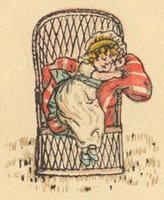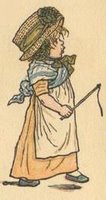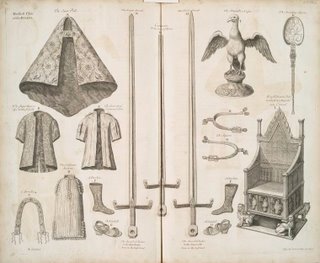 The first plate of the regalia : the open pall, the supertunica of cloath of gold, the surcoat of crimson sattin, a armilla, the colobium sindonis, a buskin, a sandall, the spurrs, the ampulla or eaglet, the anointing spoon, King Edwards Chair in which his Majestie was crownd, curtana or the sword of mercy, the second sword, the third sword.
The first plate of the regalia : the open pall, the supertunica of cloath of gold, the surcoat of crimson sattin, a armilla, the colobium sindonis, a buskin, a sandall, the spurrs, the ampulla or eaglet, the anointing spoon, King Edwards Chair in which his Majestie was crownd, curtana or the sword of mercy, the second sword, the third sword.
 The second plate of the regalia : St. Edward's crown, The crown of state, the orbe, the queens circle, the crown wherwith the queen was crowned, the rich crown, the king's coronation ring, St. Edward's staff,..., the Queen's scepter.
The second plate of the regalia : St. Edward's crown, The crown of state, the orbe, the queens circle, the crown wherwith the queen was crowned, the rich crown, the king's coronation ring, St. Edward's staff,..., the Queen's scepter.
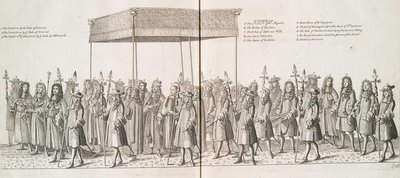 The orb, borne by the Duke of Someset; the crown, borne by the Duke of Ormond; the scepter with the dove, borne by the Duke of Albemarle;...gentlemen pensioners.
The orb, borne by the Duke of Someset; the crown, borne by the Duke of Ormond; the scepter with the dove, borne by the Duke of Albemarle;...gentlemen pensioners.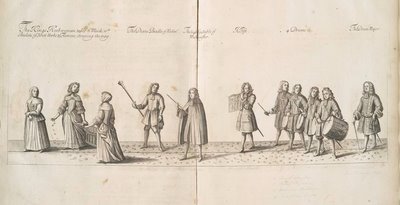 The Kings Herb-woman, & her 6 Maids, with baskets of sweet herbs & flowers, strewing the way; the deans beadle of Westin; the high constable of Westminster; a fife; drums; the drum major.
The Kings Herb-woman, & her 6 Maids, with baskets of sweet herbs & flowers, strewing the way; the deans beadle of Westin; the high constable of Westminster; a fife; drums; the drum major. A marchioness; York herald alone, Windsor herald supplying the place of Garter; Duchesses, in number eight; a duke.
A marchioness; York herald alone, Windsor herald supplying the place of Garter; Duchesses, in number eight; a duke. The manner of the champions performing the ceremony of the challenge.
The manner of the champions performing the ceremony of the challenge. The inthronization of their Majesties King James the second and Queen Mary.
The inthronization of their Majesties King James the second and Queen Mary. A representation of the fire-works upon the River of Thames, over against Whitehall, at their Majesties coronation Apr. 1685.
A representation of the fire-works upon the River of Thames, over against Whitehall, at their Majesties coronation Apr. 1685.[click images for full size versions]
The History of the Coronation Of the Most High, Most Mighty, and Most Excellent MONARCH, JAMES II. By the Grace of GOD, KING of England, Scotland, France and Ireland, DEFENDER OF THE FAITH, &C. And of His Royal Consort QUEEN MARY: Solemnized in the Collegiate Church of St. PETER in the City of WESTMINSTER, on Thursday the 23 of April, being the Festival of St. George, in the Year of Our Lord 1685.
With an Exact Account of the several Preparations in Order thereunto, Their MAJESTIES most Splendid PROCESSIONS, and Their Royal and Magnificent FEAST in WESTMINSTER-HALL. The Whole WORK Illustrated with SCULPTURES. By his Majesties Especial Command. By FRANCIS SANDFORD Esq; Lancaster Herald of Arms. In the Savoy: Printed by Thomas Newcome, One of His Majesties Printers. 1687.
All the images from the festival book, The History of the Coronation of James II, are online at NYPL.
Originally I found example images at
Octavo Books - they have the complete work online together with some background commentary. But the images are smaller; the actual text is only occasionally readable anyway.
Trivia: Samuel Pepys held one of the 4 canopy poles covering the
King during the procession. 1445 meat dishes were consumed at the party. James II was removed from the throne by the
Glorious Revolution a year after the publication of this book. Sandford died later in a debtor's prison, partly as a result of this book having such a small market.






























